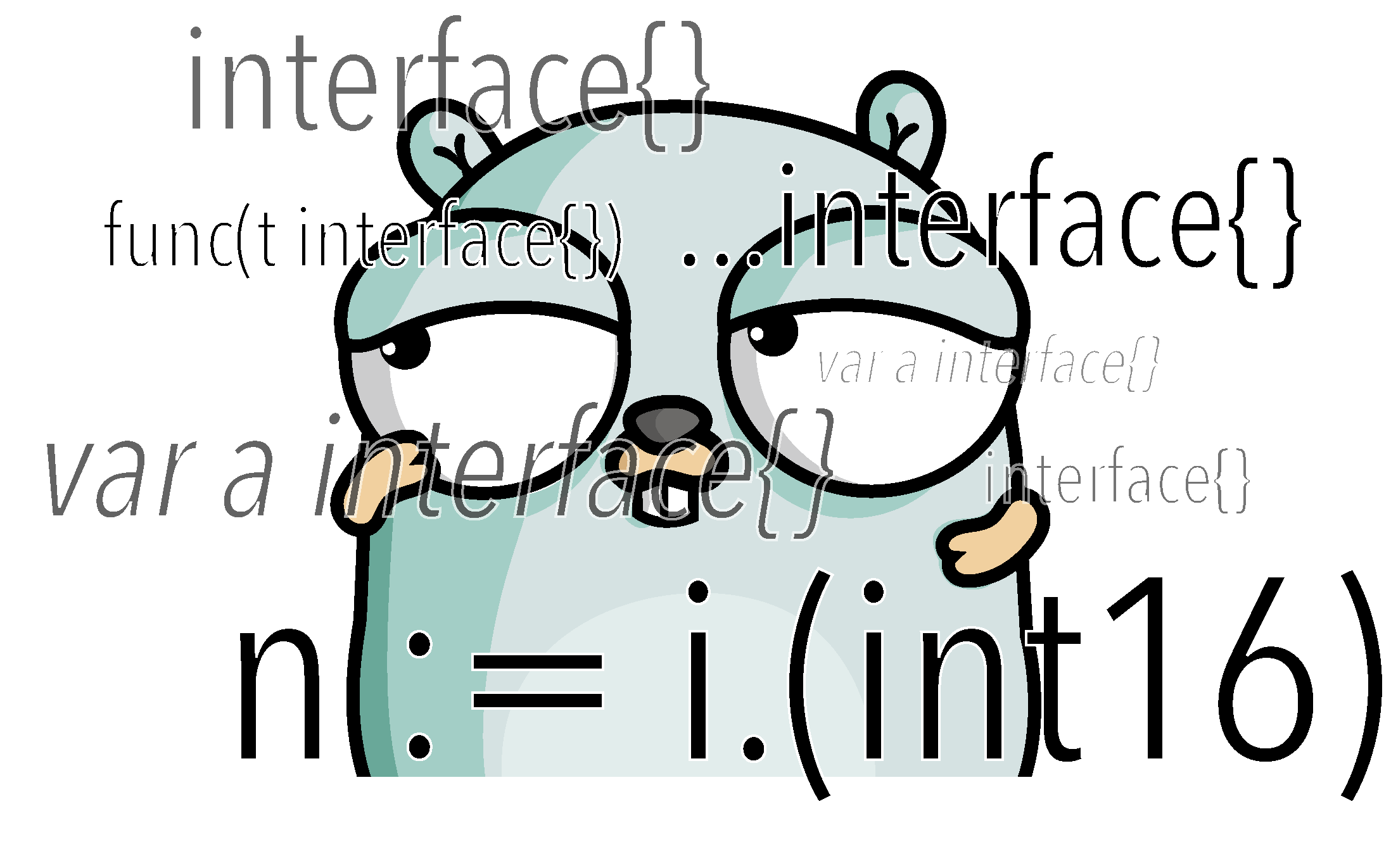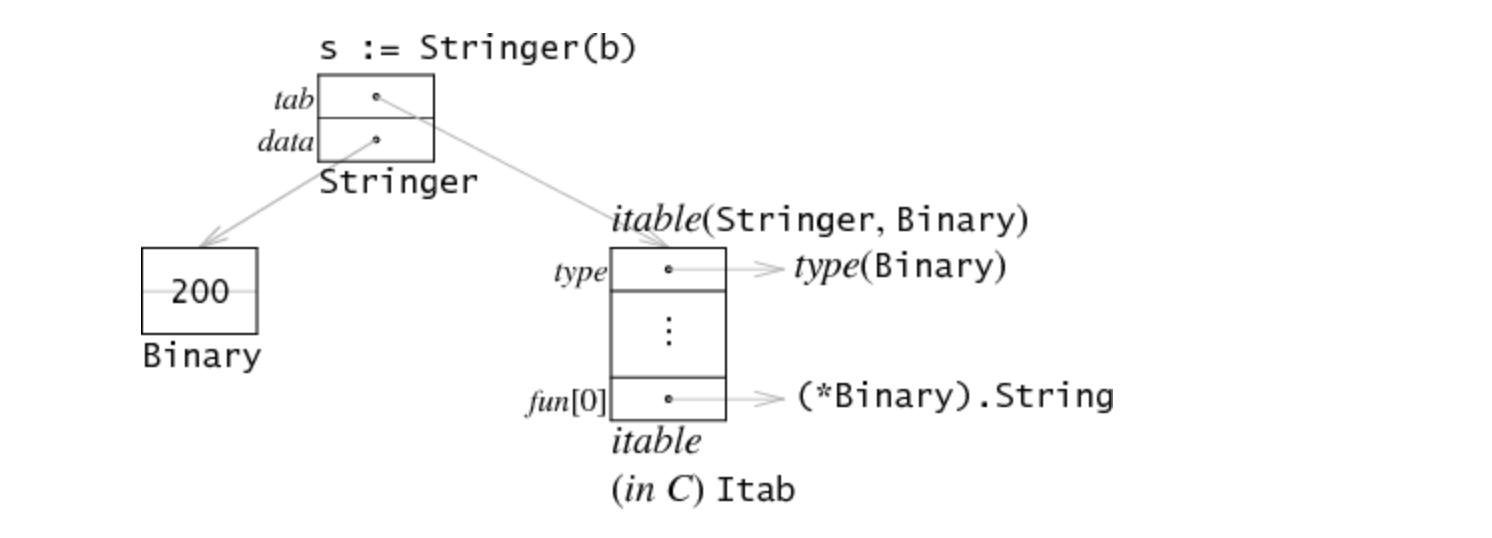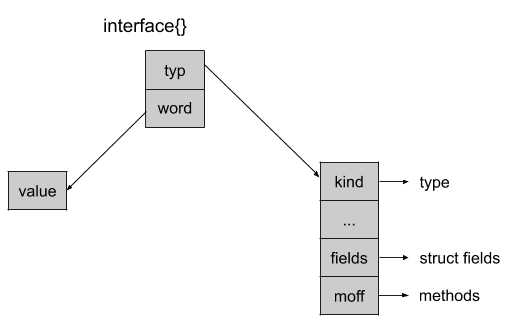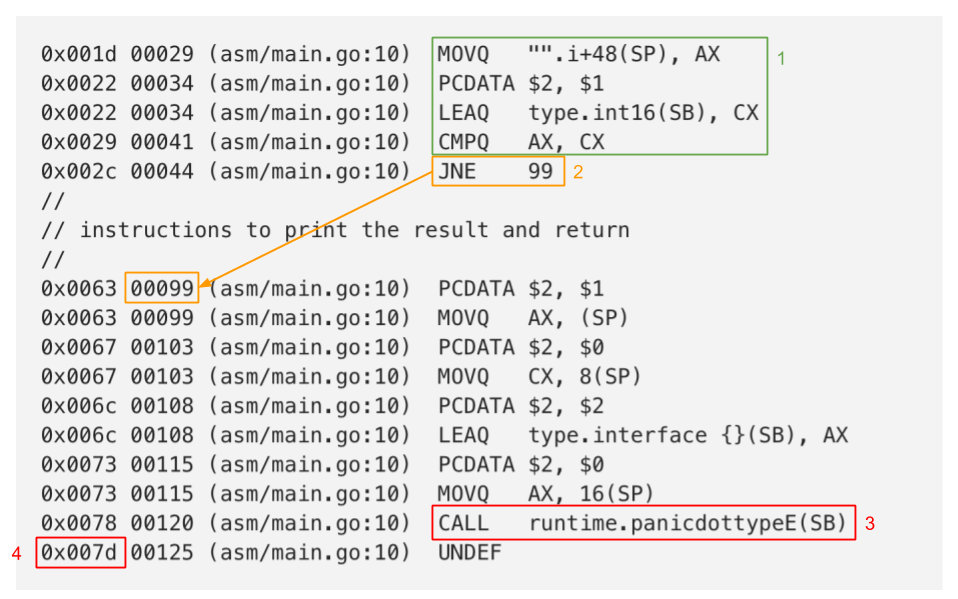首发于:https://studygolang.com/articles/24407
理解 Go 的空接口

空接口可用于保存任何数据,它可以是一个有用的参数,因为它可以使用任何类型。要理解空接口如何工作以及如何保存任何类型,我们首先应该理解空接口名称背后的概念。
接口(interface{})
Jordan Oreilli 对空接口的一个很好的定义:
接口是两件事物:它是一组方法,但它也是一种类型。
interface{}类型是没有方法的接口。由于没有implements关键字,所有类型都至少实现零个方法,并且自动满足接口,所有类型都满足空接口。
因此,空接口作为参数的方法可以接受任何类型。Go 将继续转换为接口类型以满足这个函数。
Russ Cox 撰写了一篇 关于接口内部结构的精彩文章,并解释了接口由两个指针组成:
- 指向类型相关信息的指针
- 指向数据相关信息的指针
以下是 Russ 在 2009 年画的示意图,当时 runtime 包还是用 C 语言编写:

现在,runtime 包改用 Go 编写,但结构未变。我们可以通过打印空接口来验证:
func main() {
var i int8 = 1
read(i)
}
//go:noinline
func read(i interface{}) {
println(i)
}
(0x10591e0,0x10be5c6)
两个地址分别代表了类型信息和值的两个指针。
底层结构
空接口的底层结构记录在反射包中 reflect/value.go:
type emptyInterface struct {
typ *rtype // 类型描述
word unsafe.Pointer // 值
}
正如之前解释的那样,我们可以清楚的看到空结构体有一个类型描述字段和一个包含着值的字段。
rtype 结构体包含了类型的基本描述信息:
type rtype struct {
size uintptr
ptrdata uintptr
hash uint32
tflag tflag
align uint8
fieldAlign uint8
kind uint8
alg *typeAlg
gcdata *byte
str nameOff
ptrToThis typeOff
}
在这些字段中,有些非常简单,且广为人知:
size是以字节为单位的大小kind包含类型有:int8,int16,bool 等。align是变量与此类型的对齐方式
根据空接口嵌入的类型,我们可以映射导出字段或列出方法:
| 译者注:方法在结构体最下面,这篇文章中是看不到的;需要先将这个 rtye 映射成 结构体才能看到,映射是基于 tflag 做的
type structType struct {
rtype
pkgPath name
fields []structField
}
这个结构还有两个映射,包含字段列表。它清楚地表明,将内建类型转换为空接口将导致扁平转换(译者注:不需要做其他额外的处理),其中字段的描述及值将存储在内存中。
下边是我们看到的空结构体的表示:

现在让我们看看空接口实际上可以实现哪种转换。
转换
让我们尝试一个使用空接口的简单程序进行错误转换:
func main() {
var i int8 = 1
read(i)
}
//go:noinline
func read(i interface{}) {
n := i.(int16)
println(n)
}
虽然转换 int8 为 int16 是有效的,但程序还是会 panic 异常:
panic: interface conversion: interface {} is int8, not int16
goroutine 1 [running]:
main.read(0x10592e0, 0x10be5c1)
main.go:10 +0x7d
main.main()
main.go:5 +0x39
exit status 2
让我们生成 asm 代码,以便查看 Go 执行的检查:

有以下几个步骤:
-
步骤 1:比较
int16类型与空接口的内部类型:比较(指令CMPQ)int16类型(加载有效地址LEAQ(Load Effective Address)到空接口的内部类型(从空接口MOVQ的内存段读取 48 字节偏移量的内存的指令) -
step 2:
JNE指令,即不相等则跳转指令(Jump if Not Equal),会跳转到已生成的处理错误的指令,这些指令将在步骤中处理错误 3 -
步骤 3:代码将
panic并生成我们上面看到的错误信息 -
步骤 4:这是错误指令的结束。此特定指令由显示指令的错误消息引用:
main.go:10 +0x7d
任何从空接口内部类型的转换,都应该在原始类型转换完成后进行。这种转换为空接口,然后转换回原始类型会导致程序损耗。让我们运行一些基准测试来简单了解一下。
| 译者注:这句话是说,比如 interface{} 存了一个 int16; 需要转换为 int32 时,不能直接 interface{}-> int32;应该是 interface{}->int16->int32,这也是上面的例子 panic 的原因
性能
下边是两个基准测试。一个使用结构的副本,另一个使用空接口:
package main_test
import (
"testing"
)
var x MultipleFieldStructure
type MultipleFieldStructure struct {
a int
b string
c float32
d float64
e int32
f bool
g uint64
h *string
i uint16
}
//go:noinline
func emptyInterface(i interface {}) {
s := i.(MultipleFieldStructure)
x = s
}
//go:noinline
func typed(s MultipleFieldStructure) {
x = s
}
func BenchmarkWithType(b *testing.B) {
s := MultipleFieldStructure{a: 1, h: new(string)}
for i := 0; i < b.N; i++ {
typed(s)
}
}
func BenchmarkWithEmptyInterface(b *testing.B) {
s := MultipleFieldStructure{a: 1, h: new(string)}
for i := 0; i < b.N; i++ {
emptyInterface(s)
}
}
结果:
BenchmarkWithType-8 300000000 4.24 ns/op
BenchmarkWithEmptyInterface-8 20000000 60.4 ns/op
与结构副本(typed 函数)相比,使用空接口需要双重转换(原始类型转换为空接口然后再转换回原始类型)多消耗 55 纳秒以上的时间。如果结构中字段的数量增加,时间还会增加:
BenchmarkWithType-8 100000000 17 ns/op
BenchmarkWithEmptyInterface-8 10000000 153 ns/op
但是,有一个好的解决方案是:使用指针并转换回相同的结构指针。转换看起来像下边这样:
func emptyInterface(i interface {}) {
s := i.(*MultipleFieldStructure)
y = s
}
和上边相比,结果差异很大:
BenchmarkWithType-8 2000000000 2.16 ns/op
BenchmarkWithEmptyInterface-8 2000000000 2.02 ns/op
关于像 int 或 string 这样的基础类型,性能略有不同
BenchmarkWithTypeInt-8 2000000000 1.42 ns/op
BenchmarkWithEmptyInterfaceInt-8 1000000000 2.02 ns/op
BenchmarkWithTypeString-8 1000000000 2.19 ns/op
BenchmarkWithEmptyInterfaceString-8 50000000 30.7 ns/op
如果使用得当,在大多数情况下,空接口应该会对应用程序的性能产生真正的影响:
via: https://medium.com/a-journey-with-go/go-understand-the-empty-interface-2d9fc1e5ec72
作者:Vincent Blanchon 译者:TomatoAres 校对:DingdingZhou